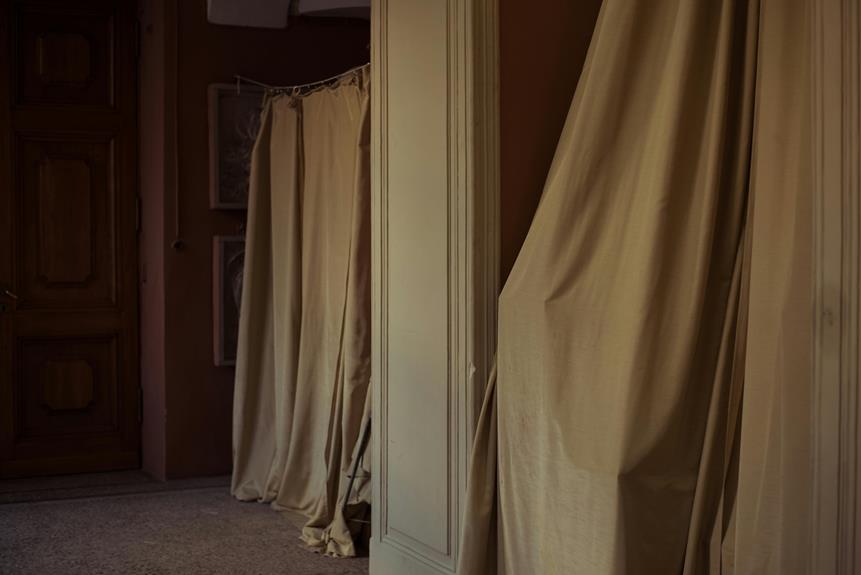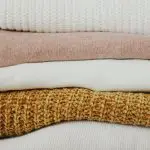If you're considering chenille for your curtains and drapes, you might be wondering whether its soft texture and rich appearance translate well to window treatments. Chenille's durability and vibrant color retention could make it an appealing choice for your home. However, like any fabric, it comes with its pros and cons that are worth exploring. Are there specific factors you should take into account before making this decision? Understanding the nuances can significantly impact your final choice…
Table of Contents
What Is Chenille Fabric?
Chenille fabric is a soft, textured material made from a combination of fibers, giving it a unique and cozy feel that's perfect for curtains. It's often made from cotton, polyester, or a blend of these fibers, which adds to its inviting appearance and tactile quality.
When you touch chenille, you'll immediately notice its raised pile texture, which creates depth and visual interest.
Originally inspired by the French word for “caterpillar,” chenille features yarns that are twisted together, forming a velvety surface that's both plush and luxurious.
This construction method not only enhances its aesthetic appeal but also makes it durable and long-lasting.
You might find chenille in various colors and patterns, allowing you to choose the perfect look for your home decor.
Its versatility means it can be used in both contemporary and traditional settings.
When considering chenille for your curtains, you'll appreciate its ability to drape beautifully, creating a serene ambiance in any room.
Advantages of Chenille for Window Treatments
When you choose chenille for your window treatments, you're opting for a fabric that offers a remarkable soft texture that enhances any room.
Not only does it feel great, but chenille is also known for its durability and longevity, making it a smart investment.
Let's explore how these advantages can elevate your home decor.
Soft Texture Appeal
The soft texture of chenille curtains invites a cozy warmth into any room, enhancing both comfort and style. When you choose chenille for your window treatments, you're not just adding fabric; you're creating an inviting atmosphere. The plush fibers provide a gentle, tactile experience, perfect for spaces where you want to unwind and relax.
You'll appreciate how chenille catches the light, diffusing it beautifully while softening harsh rays. This effect not only adds visual interest but also creates a serene ambiance. Plus, the tactile quality of chenille makes it a great choice for homes with children or pets, as its softness encourages a welcoming vibe and invites touch.
In addition, the variety of colors and patterns available means you can easily incorporate chenille curtains into your existing decor. Whether you prefer bold, vibrant hues or subtle, muted tones, there's a chenille option that will seamlessly fit into your design aesthetic. So, if you're aiming for a cozy, stylish look in your home, choosing chenille for your curtains is a decision you won't regret. It adds both charm and a unique texture that's hard to resist.
Durability and Longevity
While enjoying the cozy, soft texture of chenille curtains, you'll also appreciate their impressive durability and longevity, making them an excellent investment for your home. Unlike some delicate fabrics, chenille is resilient and can withstand the wear and tear that comes with daily use. This resilience means you won't have to worry as much about fading or tearing, allowing you to enjoy your beautiful drapes for years to come.
Chenille is easy to care for, which contributes to its longevity. A simple machine wash or spot clean is often sufficient to keep your curtains looking fresh.
Chenille drapes naturally resist creasing, so they maintain their beautiful appearance without much effort. Chenille holds dyes well and won't fade quickly in sunlight. Chenille complements various interior styles, ensuring that your windows look great no matter your decor changes.
With its blend of style and strength, choosing chenille curtains is a smart decision for any home.
Disadvantages of Using Chenille
Chenille's luxurious texture might be tempting, but its drawbacks, like difficulty in cleaning and potential fading, can be a concern for homeowners.
When it comes to maintenance, chenille can be tricky. Many fabrics require special care, and chenille is no exception. You might find it needs dry cleaning, which can be both inconvenient and expensive. Regular washing could ruin its texture, making it less desirable for those who want easy upkeep.
Additionally, if you live in a sunlit area, you'll want to consider the risk of fading. Chenille fabrics may lose their vibrancy over time if exposed to direct sunlight. This fading can alter the look of your beautiful curtains, making them appear dull and worn.
Moreover, chenille can attract dust and lint, which means you could spend more time cleaning them than you'd like. If you're sensitive to allergens, this added dust collection might be a concern.
Chenille Vs. Other Fabrics
When comparing chenille to other fabrics, you'll notice the distinct texture and softness that make it stand out.
It's also important to consider how well it withstands wear and tear, as well as how easy it's to maintain.
Understanding these differences can help you make the best choice for your curtains.
Texture and Softness Comparison
Comparing the texture and softness of chenille with other fabrics reveals why many choose it for their curtains. This plush material offers a unique tactile experience that sets it apart from standard options. Upon touch, you'll notice chenille's velvety finish, which feels inviting and cozy against your skin.
In contrast, materials like cotton, while soft, can lack that luxurious plushness, making the curtains feel less indulgent. When compared to silk, which has a beautiful sheen, chenille's matte appearance can still evoke warmth that silk mightn't always provide.
You'll find that chenille offers substantial thickness, creating a comforting barrier against light and sound.
Fabric Comparison
- Chenille: Plush, inviting, and cozy against the skin.
- Cotton: Soft but offers a more casual feel without the luxurious depth.
Choosing the right fabric for your curtains is crucial, and chenille's unique texture and softness might just be what you're looking for to enhance your space.
Durability Against Wear
Choosing curtains involves considering how well the fabric withstands daily wear, and chenille stands out for its impressive durability.
This fabric's unique construction, with its soft pile and sturdy backing, gives it a resilience that many other materials can't match. Unlike some delicate fabrics that fray or fade quickly, chenille maintains its vibrancy and structural integrity even in busy households.
When you compare chenille to fabrics like cotton or silk, you'll find that while those materials may provide luxury, they can wear down faster.
Cotton often creases and doesn't hold up as well under constant exposure to sunlight, while silk can be prone to tearing and fading. Chenille's strength allows it to handle the daily hustle without showing significant wear and tear.
Additionally, if you have pets or kids, you'll appreciate how chenille resists snagging and pulling.
It's well-suited for high-traffic areas, staying beautiful and functional even in challenging environments. If durability is a top priority for your window treatments, chenille should definitely be on your list. You can trust its ability to endure while adding style to your space.
Maintenance and Cleaning Ease
Chenille curtains aren't only durable but also easy to maintain, making them a practical choice compared to fabrics like silk or linen that often require more specialized care. With chenille, you can enjoy beautiful drapes without the constant worry of complicated cleaning methods. A simple routine can keep your curtains looking fresh.
When it comes to maintenance, chenille offers several advantages.
- Machine Washable: Most chenille fabrics can be tossed in the washing machine, making cleaning straightforward.
- Resistant to Fading: Unlike some delicate fabrics, chenille withstands sunlight without losing its vibrant color, meaning you won't have to replace them as often.
In comparison, fabrics like silk often demand dry cleaning and special handling. Linen, while beautiful, can wrinkle easily and needs regular ironing. So when you choose chenille, you're opting for a low-maintenance fabric that lets you enjoy your space without the hassle of constant upkeep.
Care and Maintenance Tips
To keep your chenille curtains looking their best, regularly dust them and wash them according to the care label instructions.
Dust your curtains weekly with a soft cloth or a vacuum with a brush attachment to remove any accumulated dirt or debris. This helps maintain the fabric's texture and appearance.
When it's time to wash your curtains, always refer to the care label for specific guidance. Most chenille fabrics can be machine washed on a gentle cycle with cold water, but check for any unique requirements.
If they're particularly dirty or stained, spot cleaning with a mild detergent can be effective without a full wash.
Avoid using bleach or harsh chemicals, as these can damage the fabric. Instead, opt for a gentle, fabric-safe cleaner.
After washing, hang your curtains to dry or tumble dry on a low setting, ensuring they don't overheat.
When storing, keep them in a cool, dry place, away from direct sunlight to prevent fading.
Ideal Rooms for Chenille Curtains
Living rooms, bedrooms, and family spaces often benefit from the cozy texture and inviting colors that chenille curtains provide. These rooms are where you unwind, relax, and spend quality time with loved ones, making the right window treatments crucial.
Chenille curtains not only enhance the aesthetic but also offer warmth and comfort, creating a welcoming atmosphere.
Consider using chenille curtains in:
- Living Rooms: They can frame your windows beautifully, offering both style and a soft barrier against drafts.
- Bedrooms: The plush fabric helps create a serene environment, perfect for relaxation and sleep.
Styling Chenille Drapes
When styling drapes, consider how the rich texture and vibrant colors of chenille can elevate your space. Choose a color palette that complements your existing decor; whether you go for bold hues or soft pastels, chenille's tactile quality can add depth.
You might want to drape them elegantly on a tension rod or use classic curtain rings for a more structured look.
To enhance the texture, pair chenille drapes with lighter sheers, allowing natural light to filter through while maintaining privacy.
If you're working with smaller rooms, opt for vertical patterns that can create the illusion of height.
Accessorizing is key—incorporate decorative tiebacks or tassels that resonate with the colors in your room.
Layering your curtains with other textiles, like linen or velvet, can provide a visually appealing contrast.
Frequently Asked Questions
Is Chenille Fabric Suitable for Outdoor Curtains?
Chenille fabric isn't ideal for outdoor curtains. Its texture can attract dirt and moisture, leading to quicker wear and fading. You'd be better off choosing a more durable, weather-resistant fabric for outdoor use.
How Does Chenille Compare in Cost to Other Curtain Fabrics?
Chenille typically costs more than basic fabrics like cotton, but it's less expensive than luxurious options like silk. You'll find that its unique texture and durability may justify the investment for your projects.
Can Chenille Be Custom-Made for Unique Window Sizes?
Yes, you can have chenille custom-made for unique window sizes. Many fabric stores offer services to tailor your chosen material, ensuring a perfect fit for your space without compromising on style or comfort.
What Types of Lining Work Best With Chenille Drapes?
When selecting lining for chenille drapes, consider materials like cotton or blackout fabric. These options provide insulation, enhance durability, and prevent fading while ensuring your curtains maintain their luxurious look and feel for years.
Are There Hypoallergenic Chenille Options Available for Sensitive Individuals?
Yes, there are hypoallergenic chenille options available for sensitive individuals. You should look for chenille made from synthetic fibers, as they often resist allergens better than natural fibers, making your living space safer and more comfortable.
- Is Acetate Fabric Still Produced Today? The Rise and Fall of a Classic - June 24, 2025
- What’s the Best Glue for Attaching Acetate to Fabric? - June 24, 2025
- How to Handle Color Bleeding in Nylon-Acetate Blend Fabrics - June 24, 2025







